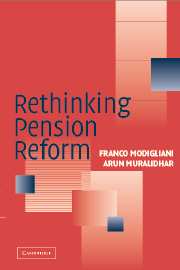Book contents
- Frontmatter
- Contents
- Preface
- Acknowledgments
- A Tribute to Franco
- Rethinking Pension Reform
- 1 A Primer on Pension Reform
- 2 A Taxonomy of Pension Reform Issues
- 3 An Evaluation of Pension Reforms
- 4 Welfare Costs of Defined Contribution Schemes
- 5 The Transition from PAYGO to Funding with a Common Portfolio: Application to the United States
- 6 Social Security Reform in Spain
- 7 The “Two-Pension Fund” Theorem
- 8 The Case for Mixed Systems and Variable Contributions: Improving the Performance of Pension Systems
- References
- Index
8 - The Case for Mixed Systems and Variable Contributions: Improving the Performance of Pension Systems
Published online by Cambridge University Press: 22 August 2009
- Frontmatter
- Contents
- Preface
- Acknowledgments
- A Tribute to Franco
- Rethinking Pension Reform
- 1 A Primer on Pension Reform
- 2 A Taxonomy of Pension Reform Issues
- 3 An Evaluation of Pension Reforms
- 4 Welfare Costs of Defined Contribution Schemes
- 5 The Transition from PAYGO to Funding with a Common Portfolio: Application to the United States
- 6 Social Security Reform in Spain
- 7 The “Two-Pension Fund” Theorem
- 8 The Case for Mixed Systems and Variable Contributions: Improving the Performance of Pension Systems
- References
- Index
Summary
INTRODUCTION
We have successfully disproved the World Bank's notion that pension reform should incorporate three pillars and have demonstrated that the World Bank's first two pillars can be integrated into one well-designed DB scheme with the “third” pillar being a voluntary DC plan. We now extend this approach to show how the first pillar can be optimally designed.
We examine two issues that we have ignored so far: (i) mixing PAYGO and funding and (ii) variable contributions. We demonstrated (in Chapter 2) how the best features of DB and DC schemes can be captured in one well-designed DB scheme – the Ideal Model. We continue to prove in this chapter that the advantages of combining PAYGO and funded DB schemes can also be assimilated into one scheme. However, in a departure from previous research, we demonstrate how this should be achieved, not just to secure the benefit of diversification (i.e., asset returns not highly correlated to wage growth) but also to limit the impact that a funded system might have on capital market efficiency.
In our scheme, individuals in a country are guaranteed pensions and the government is responsible for collecting contributions and making payments. We have also discussed how a swap contract can be used to guarantee a rate of return on fixed contributions and how the risks that returns will deviate from the guaranteed rate in the shortrun can be managed through a “sinking fund.”
- Type
- Chapter
- Information
- Rethinking Pension Reform , pp. 204 - 224Publisher: Cambridge University PressPrint publication year: 2004



